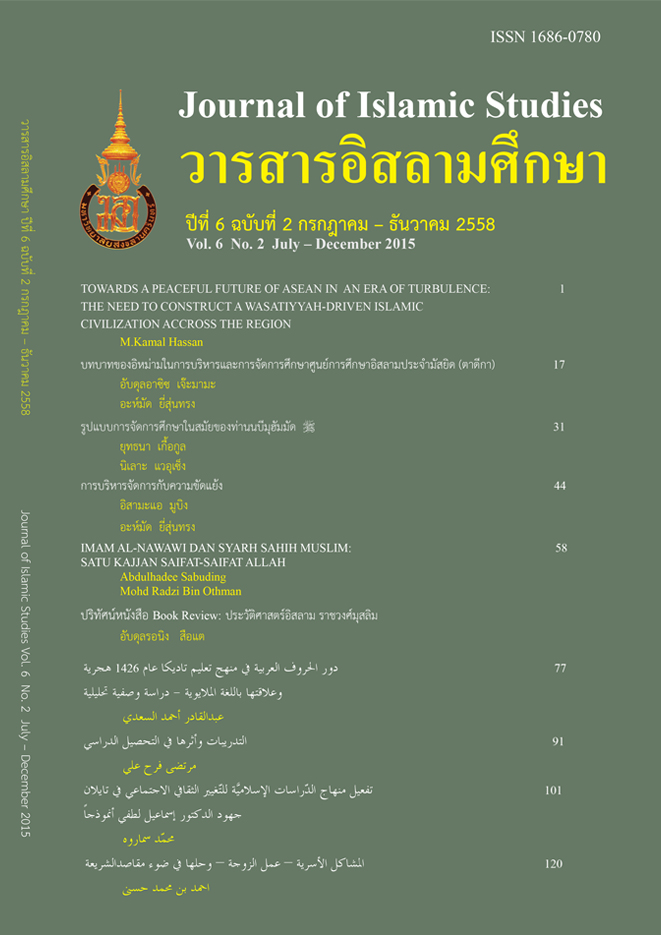دور الحروف العربية في منهج تعليم تاديكا عام 1426 هجرية وعلاقتها باللغة الملايوية - دراسة وصفية تحليلية
คำสำคัญ:
الحروف العربية, منهج, تاديكا, اللغة الملايويةบทคัดย่อ
تهدف هذه الدراسة إلى التعرف على دور الحروف العربية في منهج تعليم تاديكا عام 1426 هجرية الذي أصدرته المنطقة التعليمية الثانية عشرة وعلاقتها باللغة الملايوية والتحديات التي تواجهها اللغة الملايوية المكتوبة بالحروف العربية. ويقوم الباحث بدراسة منهج تعليم تاديكا والكتب الدراسية المقررة فيها بفطاني جنوب تايلاند. وهي دراسة مكتبية حيث اتبع الباحث المنهج الوصفي التحليلي. وقد توصل البحث إلى أن اللغة الملايوية المكتوبة بالحروف العربية ظهرت كتابتها في مؤلفات العلماء الفطانيين الأوائل منذ سنة 1224 الهجرية. كما أن منهج تعليم تاديكا عام 1426 هجرية يشمل ثماني مواد دراسية، حيث إن محتوى سبعة مواد منها مكتوب بالحروف العربية إلا مادة اللغة الملايوية فإنها مقسّمة إلى قسمين، قسم مكتوب بالحروف العربية وقسم مكتوب بالحروف اللاتينية. وأن الحروف التي تكتب بها اللغة الملايوية هي جميع الحروف العربية مع زيادة بعض الحروف حتى تتناسب مع الأصوات الملايوية المحلية وهي خ، غ، ث، ئ. وأن الكتب الدراسية المقررة التي وضعت وفق هذا المنهج تمنح فرصة كافية للدارسين لاكتساب اللغة الملايوية المكتوبة بالحروف العربية. ومع ذلك فإنها تواجه عددا من التحدّيات كعدم وجود هيئة أو جهة خاصة تتولى حفظها ورعايتها ونشرها للأجيال اللاحقة، كذلك ضعف مستوى تعليم اللغة الملايوية المكتوبة بالحروف العربية.
เอกสารอ้างอิง
أحمد فتحي الفطاني، (2001)، علماء بسر دري فطاني ، يونيبر سيتي كبغسأن مليسيا، باغي، دار الإحسان ، سلاغور كوالالمبور.
عبدالقادر أحمد، (2001)، دعوة إسلامية، ساتو كاجين ترهادف سجاره فركمباغن فنديديقكن إسلام دالم مشاركة ملايو فطاني: ساتو فغنالن، دالم جورنال فغاجين إسلام، كوليج إسلام جالا، بيلاغن 1 سبتمبر 2001.
محمد باخير الحاج عبد الله، (2006)، الخصائص اللغوية بين العربية والملايوية : دراسة مقارنة ، إسلاميات 28 / 2006، الجامعة الوطنية ماليزيا، باغي، كوالالمبور، ماليزيا.
محمد زمبري عبد المالك، (1994)، فطاني دالم تمدون ملايو، ديوان بهاس دان فوستاك، كوالالمبور.
وان محمد صغير بن عبد الله، ( 1998)، تاريخ فطاني شيخ فقيه على الفطاني، ورسي سالينن شيخ داود بن عبد الله الفطاني، الخزانة الفطانية ، كوالالمبور.
واراويت بارو، (1999)، داسر كراجأن دان كسنث ترهادف بهاس ملايو دنكارا تهاي، تيسيس انتوق ممنوهي كفرلوان إجازة دكتوراه فلسفة، جابتن فغاجين ملايو، يونيبرسيتي ملايا، كوالالمبور.
كلية الدراسات الإسلامية، (2005)، دت.
دليل الكلية الإسلامية جالا، (1999).
กรมการปกครอง กระทรวงมหาดไทย มาตรฐานและสาระการเรียนรู้หลักสูตรอิสลามศึกษาฟัรฎูอีน ประจำมัสยิด พ.ศ. 2548 / ฮ.ศ. 1426
الشؤون الإدارية، وزارة الداخلية، المستوى والمحتوى الدراسي لمنهج الدراسات الإسلامية الأساسية بمسجد عام 2548 بوذية الموافق 1426 هجرية.
เผยแพร่แล้ว
รูปแบบการอ้างอิง
ฉบับ
ประเภทบทความ
สัญญาอนุญาต
บทความทุกเรื่อง ที่ได้รับการตีพิมพ์ในวารสารอิสลามศึกษาเป็นแนวคิดของผู้เขียน มิใช่เป็นความคิดเห็นคณะผู้จัดทำและมิใช่ความรับผิดชอบของคณะวิทยาการอิสลาม กองบรรณาธิการไม่สงวนสิทธิ์การคัดลอก แต่ให้มีการอ้างอิงแสดงที่มา




